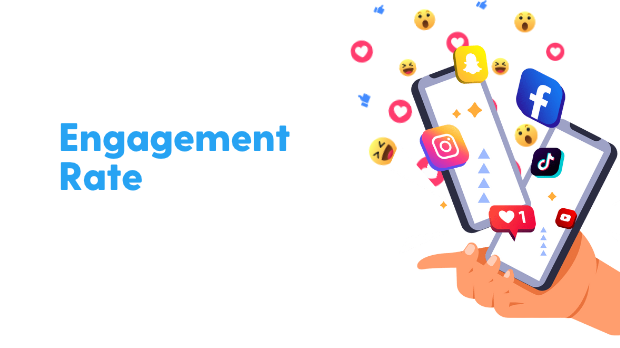In today’s digital age, engagement rate is a crucial metric for businesses and marketers. In this comprehensive guide, we will delve into the world of engagement rate, exploring its definition, importance, and various strategies to improve it.
What is Engagement Rate
Engagement rate is a key performance indicator (KPI) used to measure the effectiveness of various activities, such as marketing campaigns, content, emails, or app usage. It helps to understand how well your audience is interacting with your content, products, or services. Although engagement rate can be calculated differently depending on the context, it is generally calculated as the total number of engagements divided by the total reach or impressions, multiplied by 100 to get a percentage.
1. eCommerce engagement rate: In an eCommerce context, engagement can be determined by various factors such as clicks, add-to-cart actions, wish list additions, or product reviews. To calculate the engagement rate, divide the total number of these engagements by the total number of visitors and multiply by 100.
eCommerce Engagement Rate = (Total Engagements / Total Visitors) x 100
2. App engagement rate: For app engagement, factors such as active users, session duration, and in-app actions are considered. The engagement rate can be calculated by dividing the total number of in-app actions by the total number of active users and multiplying by 100.
App Engagement Rate = (Total In-app Actions / Total Active Users) x 100
3. Content engagement rate: In a content context, engagement rate can be determined by factors such as page views, comments, shares, or likes. To calculate the engagement rate, divide the total number of these engagements by the total number of content views and multiply by 100.
Content Engagement Rate = (Total Engagements / Total Content Views) x 100
4. Marketing engagement rate: In marketing, especially for social media, engagement rate is calculated using likes, comments, shares, retweets, or clicks on a particular post or ad. Divide the total number of engagements by the total reach or impressions of the post or ad and multiply by 100.
Marketing Engagement Rate = (Total Engagements / Total Reach or Impressions) x 100
5. Email engagement rate: For email campaigns, engagement rate can be measured using factors such as open rates, click-through rates, and conversion rates. To calculate the email engagement rate, you can use either the open rate or click-through rate. Divide the total number of email opens or clicks by the total number of emails delivered and multiply by 100.
Email Engagement Rate (Open Rate) = (Total Email Opens / Total Emails Delivered) x 100 Email Engagement Rate (Click-Through Rate) = (Total Email Clicks / Total Emails Delivered) x 100
It is important to note that the engagement rate is only one aspect of measuring the success of your campaigns or content. Other metrics, such as conversion rates or return on investment (ROI), should also be considered for a comprehensive evaluation of your marketing efforts.
Factors that Affect Engagement Rate
Here are some key factors that affect the engagement rates in eCommerce, App, Content, and Marketing.
- eCommerce engagement rate:
- User experience (UX): A well-designed and easy-to-navigate website can significantly impact the engagement rate.
- Product pricing: Competitive pricing and special offers can influence customer engagement.
- Product images and descriptions: High-quality images and detailed product descriptions can encourage users to engage with the products.
- Site speed: Slow-loading websites can deter visitors from engaging with the content.
- App engagement rate:
- App design: An intuitive and user-friendly app design can lead to higher engagement rates.
- App performance: A smooth-running app with minimal crashes or glitches can positively impact user engagement.
- Personalization: Tailoring content and features to individual user preferences can boost engagement.
- Push notifications: Timely and relevant notifications can encourage users to interact with the app.
- Content engagement rate:
- Quality of content: High-quality, well-researched, and relevant content can lead to higher engagement rates.
- Content format: Engaging content formats, such as videos, infographics, and interactive elements, can boost engagement.
- Headlines and titles: Compelling headlines can attract more readers and increase engagement.
- Content promotion: Effective promotion of your content on social media and other platforms can drive more traffic and increase engagement.
- Marketing engagement rate:
- Target audience: Accurately targeting the right audience can lead to higher engagement rates.
- Timing: Posting content at optimal times when your audience is most active can improve engagement.
- Visual elements: Eye-catching visuals, such as images or videos, can enhance engagement.
- Clear call-to-action (CTA): A clear and compelling CTA can encourage users to engage with your content or ad.
- Email engagement rate:
- Subject lines: Catchy and relevant subject lines can boost open rates and overall engagement.
- Personalization: Personalized email content tailored to the recipient’s interests can increase engagement.
- Email design: A clean and mobile-responsive email design can improve user experience and boost engagement.
- Send frequency: Striking the right balance in email frequency can have a significant impact on engagement rates.
Email Engagement Rate (Open Rate) = (Total Email Opens / Total Emails Delivered) x 100 Email Engagement Rate (Click-Through Rate) = (Total Email Clicks / Total Emails Delivered) x 100
It is important to note that the engagement rate is only one aspect of measuring the success of your campaigns or content. Other metrics, such as conversion rates or return on investment (ROI), should also be considered for a comprehensive evaluation of your marketing efforts.
Factors that Affect Engagement Rate
Here are some key factors that affect the engagement rates in eCommerce, App, Content, and Marketing.
- eCommerce engagement rate:
- User experience (UX): A well-designed and easy-to-navigate website can significantly impact the engagement rate.
- Product pricing: Competitive pricing and special offers can influence customer engagement.
- Product images and descriptions: High-quality images and detailed product descriptions can encourage users to engage with the products.
- Site speed: Slow-loading websites can deter visitors from engaging with the content.
- App engagement rate:
- App design: An intuitive and user-friendly app design can lead to higher engagement rates.
- App performance: A smooth-running app with minimal crashes or glitches can positively impact user engagement.
- Personalization: Tailoring content and features to individual user preferences can boost engagement.
- Push notifications: Timely and relevant notifications can encourage users to interact with the app.
- Content engagement rate:
- Quality of content: High-quality, well-researched, and relevant content can lead to higher engagement rates.
- Content format: Engaging content formats, such as videos, infographics, and interactive elements, can boost engagement.
- Headlines and titles: Compelling headlines can attract more readers and increase engagement.
- Content promotion: Effective promotion of your content on social media and other platforms can drive more traffic and increase engagement.
- Marketing engagement rate:
- Target audience: Accurately targeting the right audience can lead to higher engagement rates.
- Timing: Posting content at optimal times when your audience is most active can improve engagement.
- Visual elements: Eye-catching visuals, such as images or videos, can enhance engagement.
- Clear call-to-action (CTA): A clear and compelling CTA can encourage users to engage with your content or ad.
- Email engagement rate:
- Subject lines: Catchy and relevant subject lines can boost open rates and overall engagement.
- Personalization: Personalized email content tailored to the recipient’s interests can increase engagement.
- Email design: A clean and mobile-responsive email design can improve user experience and boost engagement.
- Send frequency: Striking the right balance in email frequency can have a significant impact on engagement rates.
These are just a few factors that can affect engagement rates in different contexts. It’s essential to analyze and optimize each factor to improve engagement and achieve better results in your campaigns.
Engagement rates vary by industry and platform, with different ranges considered average for each. For example, a good engagement rate on Instagram may be higher than that on Facebook. Understanding industry benchmarks and averages can help you set realistic goals and measure your performance against competitors.
Tools for Measuring Engagement Rate
There are numerous tools available to measure and track engagement rates across different platforms. Some of these tools include:
- Google Analytics:
- A widely used web analytics tool to track user engagement on websites and web applications.
- Provides data on metrics like page views, time on site, bounce rate, and user demographics.
- Adobe Analytics:
- A comprehensive web analytics tool for tracking user engagement and behavior on websites, apps, and other digital platforms.
- Offers advanced segmentation, real-time analysis, and integration with other Adobe products.
- Mixpanel:
- A product analytics platform to measure user engagement and analyze user behavior in websites and mobile apps.
- Offers event tracking, funnel analysis, and cohort analysis to better understand user interactions.
- Hotjar:
- A behavior analytics and user feedback tool that provides insights into user engagement through heatmaps, session recordings, and surveys.
- Helps identify areas of improvement on websites to enhance user experience and engagement.
- Hootsuite:
- A social media management platform to monitor, measure, and analyze social media engagement.
- Provides engagement rate data for various social media platforms, including Facebook, Twitter, Instagram, and LinkedIn.
- Sprout Social:
- A social media management and analytics tool for tracking engagement, reach, and impressions on social platforms.
- Offers detailed reporting, competitor analysis, and audience insights.
- Mailchimp:
- An email marketing platform that tracks email engagement metrics, such as open rate, click-through rate, and conversion rate.
- Provides A/B testing, list segmentation, and in-depth analytics to optimize email campaigns.
- Google Play Console and App Store Connect:
- Tools provided by Google and Apple to measure user engagement and performance metrics for Android and iOS apps, respectively.
- Offer insights on app usage, retention, crash reports, and ratings to help improve app engagement.
- Kissmetrics:
- A customer analytics platform that tracks user engagement and behavior on websites and apps.
- Provides insights into customer journey, funnel analysis, and cohort analysis to optimize user engagement.
- Crazy Egg:
- A website optimization tool that tracks user engagement through heatmaps, scroll maps, and click maps.
- Offers A/B testing and user feedback collection to enhance user experience and engagement.
These tools can help you measure, track, and optimize engagement rates across various channels, enabling data-driven decisions to improve your marketing and user experience efforts.
Tracking Engagement Across Channels
A modern data stack helps organizations measure and analyze engagement across various channels by collecting, processing, and visualizing data from multiple sources in a streamlined manner.
By leveraging a modern data stack, organizations can measure engagement across channels more effectively. Here’s a high-level process:
- Collect engagement data: Use data collection tools to gather raw engagement data from various channels, such as website analytics, mobile app analytics, social media interactions, and email campaign metrics.
- Integrate data sources: Use data integration tools to consolidate the collected data and send it to a centralized data storage solution, such as a data warehouse or data lake.
- Transform and prepare data: Clean, preprocess, and transform the raw data into a format suitable for analysis. This may involve deduplicating data, aggregating data points, or calculating engagement metrics like engagement rate, bounce rate, or click-through rate.
- Analyze and visualize data: Use data visualization and analysis tools to explore the transformed data, visualize trends, and identify patterns. Create dashboards and reports to monitor engagement metrics across channels, compare channel performance, and track the effectiveness of engagement strategies.
- Act on insights: Based on the insights gained from the analysis, optimize engagement strategies, allocate resources more effectively, and make data-driven decisions to improve customer engagement across channels.
A robust data foundation and a trusted data partner are essential for implementing data initiatives in a holistic way, as opposed to relying on point solutions.
Conclusion
Engagement rate is a powerful metric that can drive business growth and success. By understanding its importance and implementing strategies to improve it, you can foster meaningful connections with your audience and achieve your marketing goals.
As a trusted partner, Saras Analytics has helped hundreds of eCommerce brands set up modern data stacks and automated dashboards for tracking and acting on insights that matter. Are you ready to unlock the full potential of your data? Contact Saras Analytics today and let us help you harness the power of data-driven decision-making for your business.












